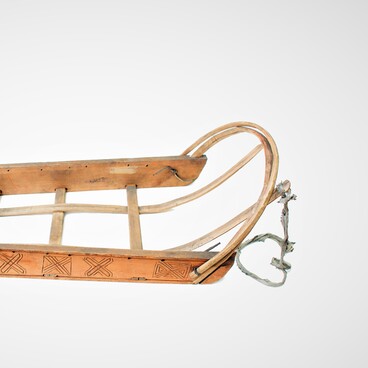The traditional doshpuluur (doshpulduur, toshpuluur) is a two-stringed plucked instrument. It consists of two main parts: a body, which is covered on both sides with leather, and a long neck that goes through it.
The flat wooden body was shaped like a trapezoid. It was mostly made from larch wood, occasionally from spruce, pine, or cedar. Great attention was paid to the place where the wood itself grew when choosing the wood for the instrument. Tuvan craftsmen preferred larch that grew in the shade, in a swampy area, rather than on the high ground and in the open sun. The larch, which grew up in a cool and humid place, had the annual rings pressed closer together, which made the wood stronger and the instrument sounded better.
To make it in less time and to make the instrument more resonant, the wood from the tree that was struck by lightning was also used. Such material was stronger and more durable.
To prevent the wood from cracking when working on the instrument, it was first boiled and then completely dried. The workpiece was either smeared with fresh manure or buried in it and then left in the shade for a long time. After such treatment, the tool took on a reddish-brown hue.
The corners of the body were joined in a manner typical of Tuvan carpenters — so that the prongs of one plane of wood fell into the grooves of the other plane. This method was called ‘aptara azyy’, and it was also used to fasten the corners of chests.
The neck of the musical instrument and the head in the form of a spatula was made from a single piece of birch. The bottom and the deck were covered with the skin of a goat, calf or red deer, and hunters used the skin of a roe deer or deer. But the skin, taken off a mountain goat in spring, was considered the best. If they wanted the instrument to sound stronger and more pleasant — they covered the body with leather from a horse’s muzzle. Then strings of twisted horse-tail hair, and sometimes of twisted lamb’s guts were stretched on the dushpuluur.
Tuvans believed that a special bond was established between the man and the tool he made. Often the doshpuluur was treated as a living being — for example, treated to wine so that the voice and heart of the instrument did not disappear during the game.
The flat wooden body was shaped like a trapezoid. It was mostly made from larch wood, occasionally from spruce, pine, or cedar. Great attention was paid to the place where the wood itself grew when choosing the wood for the instrument. Tuvan craftsmen preferred larch that grew in the shade, in a swampy area, rather than on the high ground and in the open sun. The larch, which grew up in a cool and humid place, had the annual rings pressed closer together, which made the wood stronger and the instrument sounded better.
To make it in less time and to make the instrument more resonant, the wood from the tree that was struck by lightning was also used. Such material was stronger and more durable.
To prevent the wood from cracking when working on the instrument, it was first boiled and then completely dried. The workpiece was either smeared with fresh manure or buried in it and then left in the shade for a long time. After such treatment, the tool took on a reddish-brown hue.
The corners of the body were joined in a manner typical of Tuvan carpenters — so that the prongs of one plane of wood fell into the grooves of the other plane. This method was called ‘aptara azyy’, and it was also used to fasten the corners of chests.
The neck of the musical instrument and the head in the form of a spatula was made from a single piece of birch. The bottom and the deck were covered with the skin of a goat, calf or red deer, and hunters used the skin of a roe deer or deer. But the skin, taken off a mountain goat in spring, was considered the best. If they wanted the instrument to sound stronger and more pleasant — they covered the body with leather from a horse’s muzzle. Then strings of twisted horse-tail hair, and sometimes of twisted lamb’s guts were stretched on the dushpuluur.
Tuvans believed that a special bond was established between the man and the tool he made. Often the doshpuluur was treated as a living being — for example, treated to wine so that the voice and heart of the instrument did not disappear during the game.



